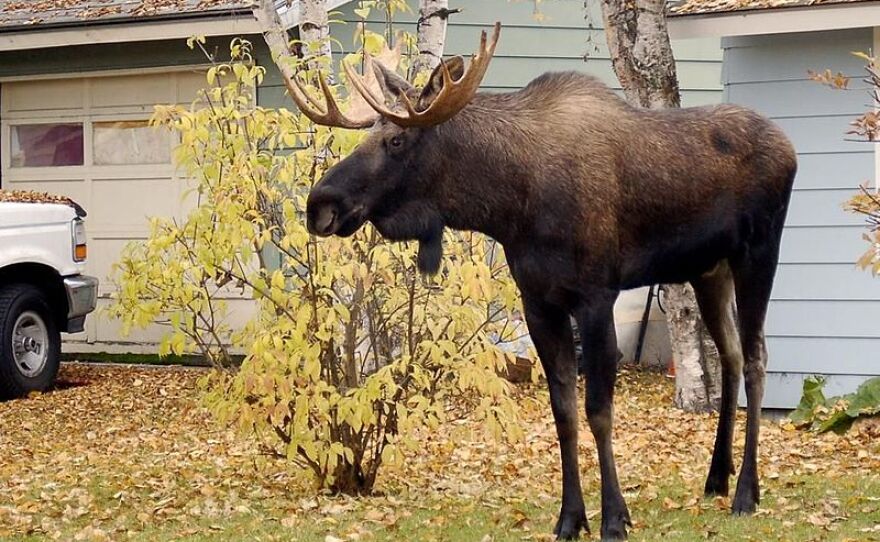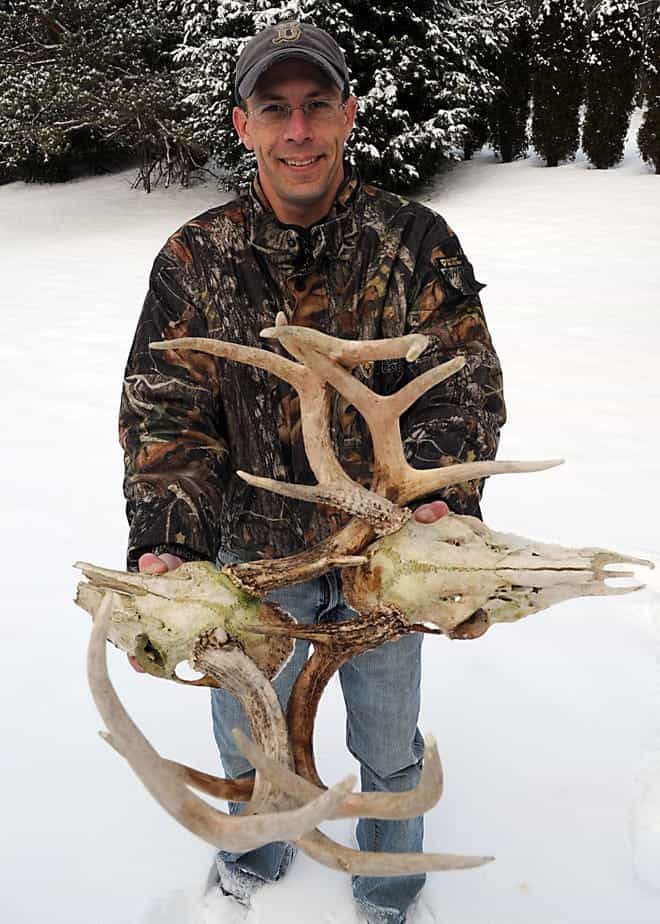Moose antlers can weigh up to 40 pounds. The weight varies by age and size.
Moose are majestic creatures that roam the vast landscapes of North America. Known for their impressive size and unique antlers, these animals have captured the fascination of many. The weight of moose antlers is a topic of interest among wildlife enthusiasts and researchers.
Understanding the weight of moose antlers can provide valuable insights into the biology and behavior of these magnificent animals. We will explore the factors that contribute to the weight of moose antlers, the importance of antlers for moose survival, and how these antlers play a role in their mating rituals. By delving into the world of moose antlers, we can gain a deeper appreciation for these remarkable creatures and the natural world they inhabit.
/bnn/media/post_attachments/content/uploads/2024/01/newfoundland-moose-population-decline-20240106093821.jpg)
Credit: bnnbreaking.com
The Importance Of Moose Antlers
Moose antlers play a crucial role in the life of these magnificent creatures. From Mating Rituals to Physical Protection, these impressive appendages are essential for survival and reproduction.
Mating Rituals
During mating season, male moose use their antlers in competitive displays to attract females. The size and strength of the antlers often determine the male’s ability to dominate other males and secure mating opportunities.
Physical Protection
Moose antlers also serve as a means of defense against predators and other threats. The intimidating size and sharp points of the antlers can deter predators and help the moose protect themselves and their offspring.
Understanding The Anatomy Of Moose Antlers
Moose antlers are remarkable appendages that play a crucial role in various aspects of a moose’s life. Let’s delve into the intricate details of these majestic structures.
Growth Process
Moose antlers begin their growth in the spring, covered in a soft layer called velvet, rich in blood vessels.
This velvet aids in the rapid growth of the antlers, which can expand up to an inch per day.
Structural Composition
- Moose antlers are primarily made of bone, specifically calcium and phosphorus.
- They consist of two main beams known as palms, with additional tines branching off.
| Component | Description |
|---|---|
| Palms | The main beams of the antlers. |
| Tines | Smaller branches extending from the palms. |
These antlers play a vital role in various aspects of the moose’s life, from display and dominance to defense.
Factors Affecting Moose Antler Weight
Age And Health
Moose antler weight is influenced by various factors, including the age and health of the moose. Younger moose typically have lighter and less branched antlers, which progressively increase in weight and complexity with age. Moreover, the health of the moose, particularly its nutritional status and general well-being, plays a crucial role in determining the thickness and weight of antlers.
Environmental Conditions
The environment in which a moose resides significantly impacts the weight of its antlers. Colder climates tend to promote thicker and heavier antler growth due to the need for added insulation. On the other hand, harsh environmental conditions, such as limited food supply or excessive heat, can negatively impact the development of moose antlers, resulting in lighter and less substantial antlers.

Credit: www.wxpr.org
Measuring Moose Antler Weight
Understanding the weight of moose antlers is a fascinating topic for wildlife enthusiasts and researchers alike. The antlers of a moose are not only an impressive sight, but they also serve crucial purposes such as attracting mates and establishing dominance. In order to gain insights into antler weight and its potential implications, researchers employ various techniques and collect relevant data.
Research Techniques
Measuring moose antler weight requires careful scientific methods. Researchers utilize a range of techniques to ensure accurate measurements:
1. Antler Sheds
One common approach to determine antler weight involves studying antler sheds. During the autumn months, moose naturally shed their antlers, providing researchers with an opportunity to collect and analyze them. By weighing these sheds, scientists can estimate the weight of attached antlers during the rutting season.
2. Field Observations
Observing moose in their natural habitat allows researchers to estimate antler weight visually. Through comprehensive field studies, scientists gather substantial data by closely observing moose behavior during different stages of antler growth. This method provides valuable real-time insights into antler size and weight changes.
Data Collection
Accurate data collection plays a critical role in understanding the variations in moose antler weight:
1. Camera Traps
To capture data without direct human interference, researchers use camera traps. These remote cameras are strategically placed in moose habitats, capturing images of the animals as they move past. By analyzing these images, researchers can identify moose and estimate the weight of their antlers accurately.
2. Weight Calculations
Researchers also employ indirect methods for determining antler weight. By collecting measurements such as antler length, circumference, and beam diameter, they can employ mathematical models to estimate the weight of moose antlers. These calculations provide valuable insights into the weight distribution of antlers within a moose population.
In conclusion, the measurement of moose antler weight requires a combination of research techniques and data collection methods. By studying antler sheds, making field observations, and utilizing camera traps, scientists gather crucial data to understand the variations in antler weight among moose. This research serves to expand our knowledge of these majestic creatures and their significance in the natural world.
Implications For Conservation And Management
Moose antlers can weigh between 40-60 pounds, impacting their mobility and foraging behavior. Conservation efforts should consider the potential impact of heavy antlers on moose population dynamics and ecosystem health, possibly influencing management strategies to ensure the species’ well-being.
Antlers play a crucial role in the world of moose. The weight and size of moose antlers have significant implications for conservation and management efforts. Understanding these implications is vital for ensuring the health of moose populations and minimizing human-wildlife conflicts. Let’s explore two main areas where the weight of moose antlers comes into play: population health and human-wildlife conflict.Population Health
Moose antlers serve as important indicators of overall population health. By examining the size and weight of antlers, wildlife researchers and conservationists can gather valuable insights into the well-being of moose populations. Lighter antlers may be indicative of poor nutrition or genetic factors that impact growth and development. On the other hand, heavier antlers suggest healthy individuals with access to adequate food resources and suitable habitats. Such information can guide conservation efforts to focus on areas where moose populations are struggling and take appropriate actions to improve their health and survival.Human-wildlife Conflict
Moose, with their majestic antlers, are a sight to behold. However, these antlers can also pose risks in human-wildlife interactions. Heavier antlers mean more weight on moose heads and a greater potential for injury if a moose were to charge or collide with a person or vehicle. For those living or working in areas with high moose populations, understanding the weight of antlers is crucial for minimizing the risks associated with these interactions, both for human safety and the well-being of the moose. Conservation and management efforts can use this knowledge to educate the public, implement appropriate protective measures, and develop strategies to reduce conflicts and promote coexistence between humans and moose. In conclusion, the weight of moose antlers has significant implications for conservation and management. By examining the antler weight, we can assess population health and identify areas that require conservation interventions. Furthermore, understanding the weight of moose antlers helps minimize human-wildlife conflicts and ensures the safety of both individuals and moose. Through careful consideration of these factors, we can protect and preserve these magnificent creatures for generations to come.
Credit: www.wxpr.org
Frequently Asked Questions On How Heavy Are Moose Antlers
What Is The Average Weight Of Moose Antlers?
The average weight of moose antlers can range from 40 to 60 pounds. These majestic creatures grow impressive antlers to attract mates and establish dominance in their territory.
How Are Moose Antlers Beneficial To Them?
Moose antlers serve multiple purposes. They are used for defense against predators, to attract females during mating season, and for establishing dominance within the herd. The antlers are shed and regrown each year, allowing for continuous adaptation.
Do Female Moose Also Have Antlers?
No, female moose, also known as cows, do not typically have antlers. It is primarily the males, known as bulls, that grow these impressive structures. However, there have been rare cases where female moose have been observed with small antler-like growths.
Conclusion
Moose antlers can be quite heavy, with the largest ones weighing up to 40 pounds. The weight of antlers varies depending on several factors such as the age, nutrition, and genetics of the moose. Understanding the weight of moose antlers can provide valuable insight into the life and behavior of these majestic creatures.



